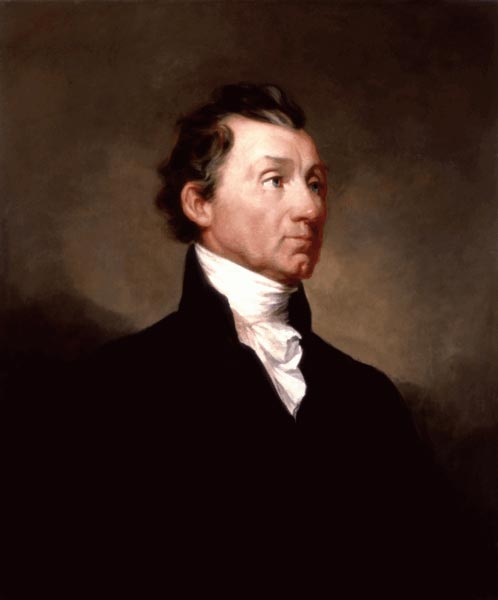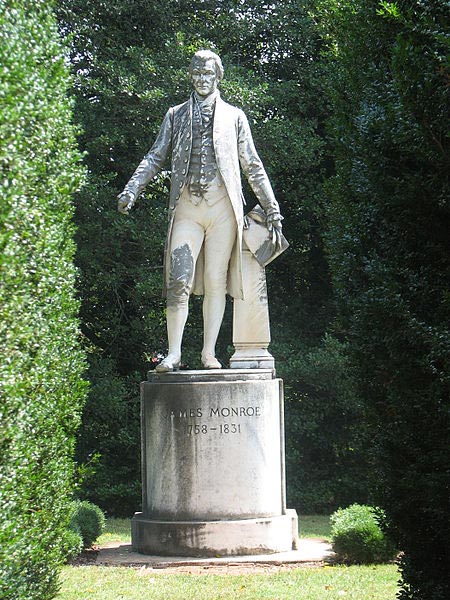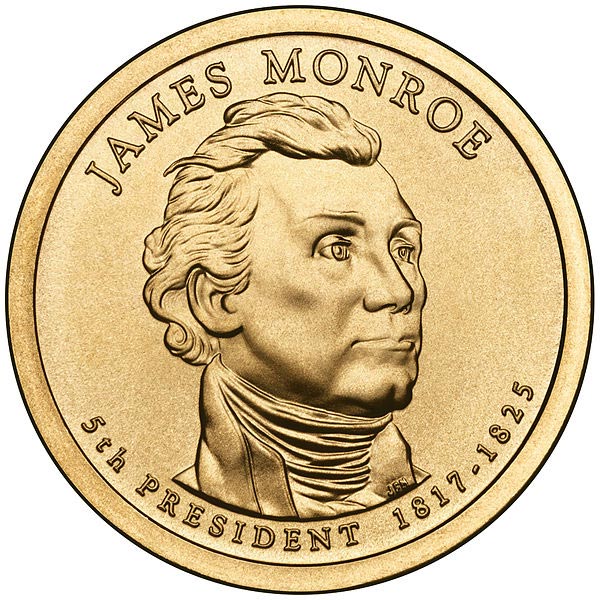| James Monroe | |
|---|---|

| |
| 5th United States President « Previous Next » |
|
| In office | Mar. 4, 1817 – Mar. 3, 1825 |
| V. President | Daniel Tompkins |
| Political Party | Democratic-Republican |
| Personal Info | |
| Born | Apr. 28, 1758 |
| Died | July 4, 1831 (at age 73) |
| Religion | Episcopal |
| School | College of William and Mary |
| Profession | Lawyer, Planter |
| Signature | |
| Wife | Elizabeth Kortright |
| Children | Eliza Monroe Hay, James Spence Monroe, Maria Hester Monroe Gouverneur |
| U.S. Presidents 1-15 | |
| 1. George Washington (1789–1797) | |
| 2. John Adams (1797-1801) | |
| 3. Thomas Jefferson (1801-1809) | |
| 4. James Madison (1809-1817) | |
| 5. James Monroe (1817-1825) | |
| 6. John Quincy Adams (1825-1829) | |
| 7. Andrew Jackson (1829-1837) | |
| 8. Martin Van Buren (1837-1841) | |
| 9. William Henry Harrison (1841-1841) | |
| 10. John Tyler (1841-1845) | |
| 11. James Knox Polk (1845-1849) | |
| 12. Zachary Taylor (1849-1850) | |
| 13. Millard Fillmore (1850-1853) | |
| 14. Franklin Pierce (1853-1857) | |
| 15. James Buchanan (1857-1861) | |
| List of All the Presidents |
The United States of America has had a fair share of Presidents, all remembered in their own ways. But there are several who are remembered as brave, bold, and strong-willed. One of them is the fifth President of the United States, James Monroe.
Monroe was the last of the Founding Fathers of the United States. His life, both personal and as a public servant, were marked by twists of fate that served as a platform for the man’s audacity. One proof is that he was considered to be the last of the US Presidents who became a Revolutionary War hero. With this bravado, he left behind a historical legacy that includes the Era of Good Feelings and the powerful Monroe Doctrine, which will be discussed in this essay of his life and contributions.
James Monroe’s Early Life
James Monroe’s biography is rich in striking details. He was born in Westmoreland County, Virginia on April 28, 1758 to Spence Monroe, a planter and carpenter, and his married wife Elizabeth Jones Monroe. James’ father was described as a fairly prosperous planter, as he had come from a line of Scottish immigrants who had patented a large piece of land in their area.
Being the eldest son, James was expected to inherit his father’s prosperity. Fortunately, he grew to be an excellent student at the Campbelltown Academy. He also gained much from his close ties with Judge Joseph Jones, who was his uncle. James had enrolled in the College of William and Mary in 1774, but it was a period of social unrest so he dropped out to join the 3rd Virginia Regiment under the Continental Army.
As part of the army, he became an officer and fought in battles. He was even shot in the shoulder at the Battle of Trenton in 1776, but eventually recovered.
Still, he continued studying law, this time under Thomas Jefferson. Historians said that James saw legal practice as a way towards wealth, status, and influence.
In between all these, James Monroe met Elizabeth Kortright. They married in February 16, 1786, and had three children. As for his fortune in his plantation, historians noted that James was not profitable in agriculture. Even more, he sold his inherited plantation, as well as other pieces of property, to support his lifestyle and his entrance to politics.
Madison’s Early Political Career
In 1782, James Monroe became part of the Virginia House of Delegates, and from 1783-1786, he was also part of the Continental Congress.
 During this period, the debate over the ratification of the Constitution was simmering. There were supporters and opponents of the ratification, but there were also those who were in the middle ground. Monroe was one of the leading personas of this middle ground. Among other concerns, they maintained that the Constitution should come with a bill of rights and that there should be amendments. This group was credited to be a primary reason behind Virginia’s eventual ratification of the Constitution.
During this period, the debate over the ratification of the Constitution was simmering. There were supporters and opponents of the ratification, but there were also those who were in the middle ground. Monroe was one of the leading personas of this middle ground. Among other concerns, they maintained that the Constitution should come with a bill of rights and that there should be amendments. This group was credited to be a primary reason behind Virginia’s eventual ratification of the Constitution.
After that, Monroe became a US Senator in 1790. He also joined Thomas Jefferson and James Madison in their party, and in 1791, he rose to become the party’s leader to the Senate.
In 1794, however, Monroe had to resign from his post in the Senate because he was appointed Minister to France. In this new position, he showed more bold acts, such as freeing Thomas Paine, who opposed the execution of Louis XVI, and freeing all Americans who were prisoners in France.
Monroe was a supporter of the French Revolution. At that time, France and Britain were at odds, and Monroe tried to assure France that America was neutral grounds. However, American policy eventually favored Britain, provoking France. Then-President George Washington then removed Monroe from being Minister to France.
Monroe returned to Virginia, and in 1799, he was elected their governor. The US President then was Thomas Jefferson, who appointed Monroe the Minister to the Court of St. James, part of Britain. Monroe proposed a new treaty with Britain, but Jefferson refused it. This eventually caused a falling out between Britain and America, and culminated in the War of 1812.
Once again, Monroe went back to Virginia and briefly served as governor. One particular incident arose in which a group of slaves planned to kidnap Governor Monroe and hold him for ransom in exchange for their freedom. This plan, named the Gabriel slave conspiracy, did not materialize because of a storm, but it solidified Monroe’s stand to emancipate the slaves. With that stand, he helped fund the freedom of the people of the West African country Liberia.
In April 1811, he became the US Secretary of State. As the war of 1812 went on, it became apparent that America was losing ground, prompting then-President James Madison to appoint Monroe Secretary of War in 1814. He had no successor as Secretary of State, so he served as both Secretary of State and Secretary of War. It was a brief juggle, however, because the war ended in the very next year, and so Monroe officially returned to being Secretary of State.
James Monroe as President
 James Monroe’s rise to and stay in the US Presidency was out of the ordinary.
James Monroe’s rise to and stay in the US Presidency was out of the ordinary.
First, in the presidential elections of 1816, the Federalists were in a disorganized state, weakening any challenger to the Anti-Federalist Monroe. Thus, with little trouble in the caucus election, he was elected US President. Then, by the time Monroe’s first term was ending, the Federalists completely collapsed and there was no proper opposition at all. Thus, with an almost unanimous vote, he was reelected into office.
During his leadership, Monroe made changes in appointments in order to balance his choices and minimize partisan tensions. This led to the “Era of Good Feelings”, a period in American history characterized by less political strife and more expressions of good will.
The President was largely praised by historians for his choices of appointees into the Administration, Cabinet, and Judiciary. Not only were his choices careful and balanced, these appointees also proved efficient in their posts. Most notable was John Quincy Adams, whom Monroe chose as the Secretary of State. Adams was a very good diplomat, largely assisting the President from his decisions down to his speeches.
Unfortunately, a great economic depression fell upon his administration, a depression known as the Panic of 1819. This affected domestic policymaking, and particularly prolonged the debate on banishing slavery in Missouri.
In addition, Monroe also had to deal with the hostile actions of the Seminole Indians, a group of Native Americans. He ordered the punishment of these Indians and their Spanish supporters. This became a national controversy and subject of heavy debate, but in the end, the House of Representatives gave some support to the President’s actions. Monroe even intended to teach the Indians to transition from their hunting stage into an agricultural society.
At that time, Florida was a territory of Spain, thus it was called Spanish Florida. Monroe’s actions against the Spanish stirred up trouble. Fortunately, with the great help of his Secretary of State John Quincy Adams, Spain signed a treaty giving back Florida to America in 1821 with the return of the $5,000,000 worth of claims.
It was also during this period that other Spanish and Portuguese colonies across Latin America rose and claimed their independence. The US expressed its support to these newly-independent countries. This was the basis of Monroe’s declaration that any European action to colonize any part of the Americas would call for the intervention of the US. This was the Monroe Doctrine, arguably the President’s most significant contribution in history. The Monroe Doctrine gained solid ground, obtaining support from Britain and even preventing Russian encroaching on the Pacific coast.
President James Monroe’s Legacy
James Monroe’s presidency ended on March 4, 1825. He stayed for a while at Monroe Hill in the University of Virginia. When his wife died in 1830, he moved to New York City and stayed with his daughter. He passed away there on July 4, 1831.
The life and leadership of this US President were truly extraordinary, and so different from the other US Presidents. America honors him by naming many places and institutions after him, and even modeling a unit of currency featuring him. Even more, the capital of Liberia adapted his name and became Monrovia, the sole non-American capital to honor an American president in such way.
Monroe’s legacy is far greater than that. In his boldness and strong will, he had contributed to the growth of United States as a top influential country in the world. With his steadfast declaration of the Monroe Doctrine, he had established a new direction in the international affairs of the United States. And with his careful choices paving the way towards the Era of Good Feelings, he had made his presidency an example for a peaceful yet powerful kind of leadership.
Most of all, the legacy of James Monroe is a model of what a brave leader can do. He dared to do difficult acts, and in return, accomplished even greater feats.